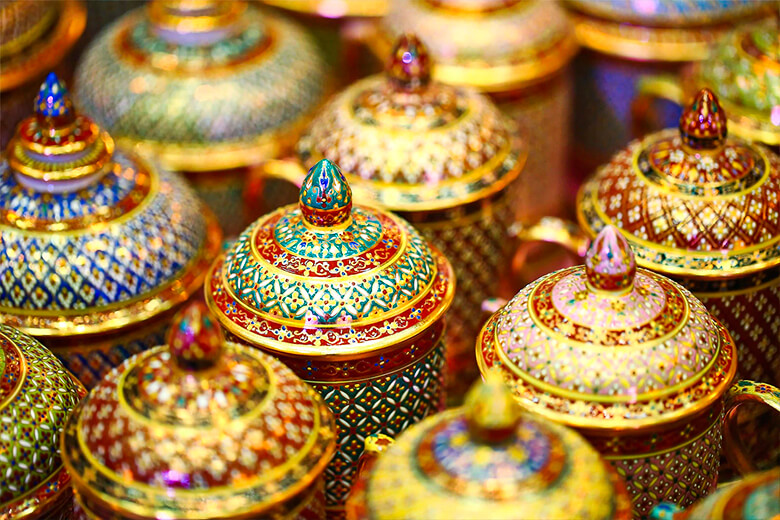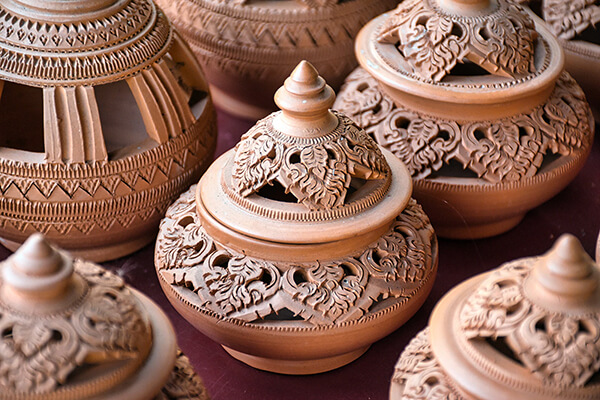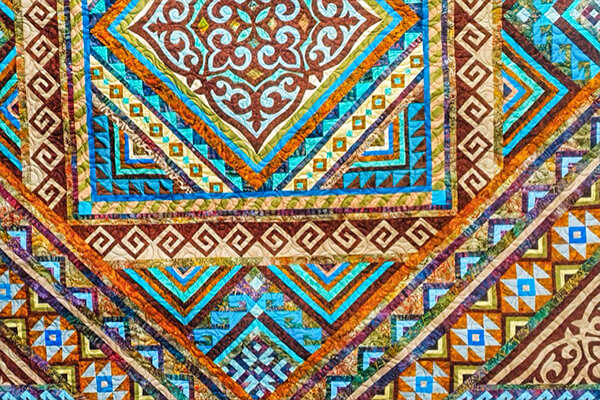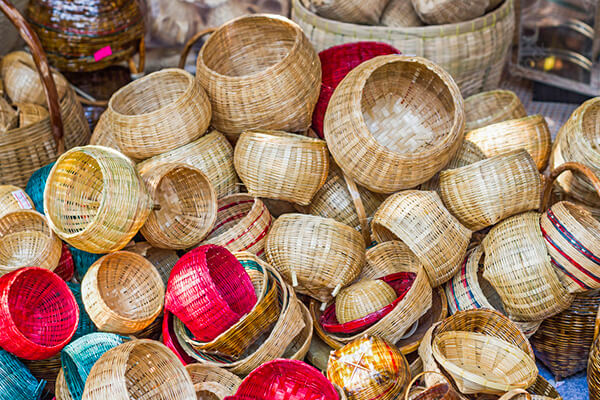
Like other nations, Thailand‘s arts and crafts reflect Thai life, culture, history, and economy. Thailand’s arts and crafts are justifiably well-known throughout the world. Hill-tribe goods, from silver jewellery to vibrant garments, lacquerware and ceramics, traditional musical instruments and puppets, are exquisite examples of the mastery of Thai artisans seeking to keep the old traditions alive.
The Best 10 Thailand’s Arts and Crafts
In Thailand, you can find many different kinds of arts and crafts. Here, we’ll outline the primary 10 categories of Thai arts and crafts.
- The weaving and silk of Thailand
- Coco sui enamel plates
- Wooden Crafts from Thailand
- Sculpture in Thailand
- Pottery in Thailand
- Textiles and Embroidery of Thailand
- Handmade Soap Flower in Thailand
- The Nielloware in Thailand
- Silverware of Thailand
- Bamboo and Rattan of Thailand
The weaving and silk of Thailand’s Handicrafts
It’s possible that northeastern Thailand, where fabric weaving is a traditional folk craft, is where the wonderfully iridescent, nubby Thai silk originated. Today, there are many silk manufacturing enterprises in or around Bangkok, but the Northeast is still the primary production region. The business Jim Thompson created has constructed the largest hand-weaving facility in the world close to the northeastern hamlet of Pak Thong Chai.
In addition to plain and patterned silks in a range of weights, a few unique weaves have gained popularity. One of them is mudmee, a style of ikat that is unique to the Northeast. Mudmee is currently widely used due to Her Majesty Queen Sirikit’s support.
The most well-known of all Thai handicrafts is currently silk, which can be purchased in innumerable local stores and all over the world. In stark contrast to its haphazard beginnings, it is now exported all over the world in plain lengths, plaids, brocades, stripes, patterns, and checks, and is backed by a sizable manufacturing and sales infrastructure.

Coco sui enamel plates of Thailand’s Handicrafts
With a pair of blue-rimmed enamel plates, you can go right whether you’re serving breakfast, lunch, or a quick snack. With his distinctive illustrations—cutesy tigers, florals, and cartoon people in bikinis—illustrator Sanon Tempiem, operating under Coco Sui, enhanced this commonplace Thai cuisine. Some of Coco Sui’s framed screenprints are available for purchase on Iconcraft if you’re looking for something more striking.
Wooden Crafts from Thailand
Thai people love carving teakwood because it is a highly sturdy material. Thanks to the exceptional talents of artisan woodcarvers, numerous beautiful wood carving sculptures can be seen in Buddhist temples and palaces all around the nation. Wooden boxes, vases, lamps, and furniture are also carved and engraved using stone, animal horns, ivory, banana stalks, and other materials. Decorative carvings can also be seen on some fruits, vegetables, and soaps.
For the creation of their handmade goods, Thai artists use readily accessible natural materials including rattan, wicker, and bamboo. Bamboo and wooden handicrafts are well-known in northern Thailand, particularly in Chiang Mai. Bamboo baskets, rattan lamps, rattan braided bags, trays, chairs, and furniture are all made by Thai artists.
Northern Thailand is well-known for its lacquerware, which is manufactured by coating a lacquer derived from the resin of the Lak tree onto teakwood or bamboo over the course of weeks or even months. After that, intricate decorations are manually painted on it. In the 18th and 19th centuries, Burmese immigrants developed the Tai Khern method, which adds ornate decorations, typically in gold leaf, to lacquerware. Additionally, you can discover craftsmen who focus on these goods.

Sculpture in Thailand
Buddhist temples and royal palaces all around Thailand are typically decorated with carvings. In addition to teak, bamboo, rattan, stone, horn, ivory, banana stalks, and mango, many other materials are carved and engraved into statues. In Thailand, teak is the most widely used wood for carving.
Thai carving craftsmen are so skilled that they can carve hard objects, delicate fruit, vegetables, and soaps. Restaurants in Thailand frequently display the work of numerous artisans who carve and engrave watermelons into unique pieces of art.
Pottery in Thailand
At Ban Chiang in northern Thailand, beautiful pots that date back more than 5,000 years have been discovered. The practice of molding and firing clay has persisted to the present day. Every part of the nation has its own distinctive traditional pottery.
A fine low-fired pot or water jug is made in the North, for instance, and is lightly glazed with terra cotta and oil to hold liquids. According to northern custom, one of these pots is placed outside most temples and private homes so thirsty strangers can pause and refresh themselves.
The northeastern city of Nakhon Ratchasima is home to kilns that produce dark brown pottery in various shapes, including flower pots and imaginative animals. Ratchaburi, west of Bangkok, is famous for its exquisitely decorated water storage jars, which are yellowish-green in color and decorated with dragons and swirling floral motifs.
Textiles and Embroidery of Thailand’s Handicrafts
Thai fabrics and silks are hand-woven goods with distinctive patterns that even machines can’t replicate. Every piece of silk is infused with a wealth of regional customs and cultural heritage. Given that they are created from silkworm cocoons, Thai silks are a symbol of indigenous knowledge. One of the most famous fabrics in the world is traditional Thai silk.

Handmade Soap Flower in Thailand
The soap blossom must be Thailand’s most popular handcraft. Handmade soap flowers are a type of handicraft that are painstakingly carved out of soap and then set in a wooden box with lovely decorations. Each of the stall owners is a talented craftsperson, using a few knives, a box of paints, and a pair of deft hands to create a variety of flowers in various shapes. It is available in Thailand’s souvenir shops and night markets. Handmade soap from Thailand has a flower-like scent, is exquisite and unique, and is ideal as a present.
The Nielloware in Thailand
The Thai term for nielloware, Khruang Thom, is thought to have arrived in the nation during the Ayutthaya era. Its exact origin is unknown; some academics claim it originated in China, while others attribute it to Persia. In any case, it developed into a significant craft in southern Thailand, especially in Nakhon Si Thammarat, where it is still carried out today.
Most fine nielloware is constructed of pure silver, with gold plating added sometimes. The artisans purchase the metal in thin sheets, from which they cut and solder the desired shape to create a simple, three-dimensional form. After the design has been engraved—often a traditional design like a Thai flame or a complex floral motif—the high relief areas are exposed to an oxidizing solution, which permanently turns them blue-black. After filing away all the sharp edges, the object receives one last polishing.
Silverware of Thailand’s Handicrafts
During the Ayutthaya and Rattanakosin eras, silverware use was very popular. Through commerce and interactions with other nations, silver was introduced to Siam. China, India, Persia, and Portugal were the original influences on the silversmithing methods. While silver goods were exclusive to royal use and noble families. These days, highly trained Thai silversmiths have produced complex, one-of-a-kind Thai silverwares that are recognized as Southeast Asia’s finest craftsmanship.
Bamboo and Rattan of Thailand’s Handicrafts
In many household craft projects, bamboo and rattan are significant materials. Chairs, baskets, beds, trays, lamps, and even bags are numerous pieces of furniture manufactured from bamboo and rattan. The majority of furniture may be made from bamboo and rattan, thanks to the skill of Thai artisans. Several artisans create bamboo furniture in a tiny shop or factory run by a family. A family passes down its bamboo-crafting expertise from one generation to the next.




